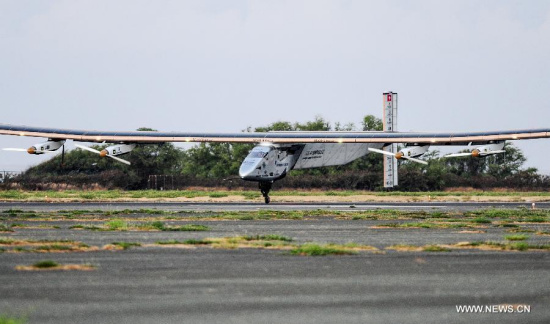
Solar Impulse 2 lands at Kalaeloa Airport in Honolulu, Hawaii, the United States, July 3, 2015. (Photo: Xinhua/Zhang Chaoqun)
After the record breaking 5 days and 5 nights solar powered flying across west Pacific, which took around 118 hours without stop, Solar Impulse 2 suffered irreversible batteries damage. And the Solar Impulse team decided to push the second half of round-the-world solar flight to April 2016.
"Solar Impulse will undergo maintenance repairs on the batteries due to damages brought about by overheating," Solar Impulse team said, "The damage to certain parts of the batteries is irreversible and will require repairs and replacements" and " the round-the-world mission will resume early April from Hawaii to the USA West Coast in 2016."
The distance of the journey from the central Japanese city of Nagoya to Honolulu was 8,200-kilometer. Solar Impulse 2 finished the trip at 5:51 a.m. local time on July 3.
Hawaii is the eighth leg of the plane's 35,000-kilometer journey around the world started from Abu Dhabi on March 9. And it is the longest and most difficult leg of the round-the-world journey.
"During the first ascent on day one of the flight from Nagoya to Hawaii, the battery temperature increased due to a high climb rate and an over insulation of the gondolas. And while the Mission Team was monitoring this very closely during the flight, there was no way to decrease the temperature for the remaining duration as each daily cycle requires an ascent to 28'000 feet and descent for optimal energy management", Solar Impulse team said in a statement on Wednesday.
"Irreversible damage to certain parts of the batteries will require repairs which will take several months," said Solar Impulse technician team, "the Solar Impulse engineering team will be studying various options for better cooling and heating processes for very long flights."
With the help of the Department of Transportation of the University of Hawaii, Solar Impulse will start the post maintenance check flights in 2016 to test the new battery heating and cooling systems.
















































